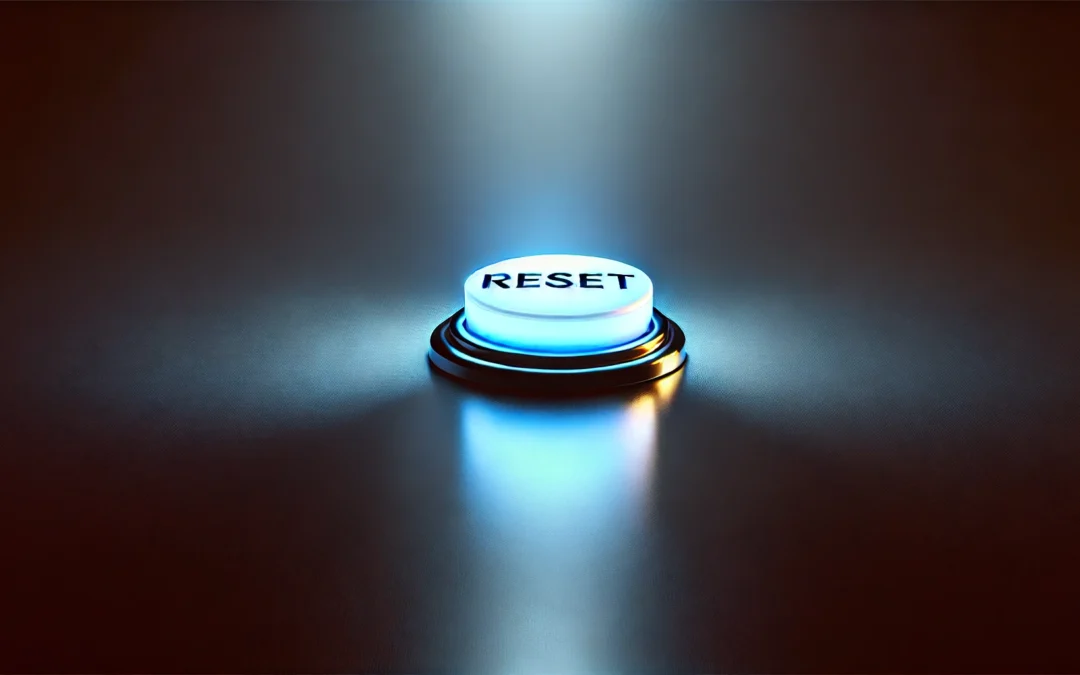Have you ever had one of those days where everything just seems to go wrong, and you wish you could simply hit a reset button? You’re definitely not alone. The concept of a reset is something we all can relate to, whether it’s starting fresh on a Monday morning or rebooting a sluggish computer. Resets can be as simple as taking a deep breath to calm your nerves or as significant as making a big life change. They offer a chance to pause, reassess, and begin anew, often leading to a clearer perspective and renewed energy.
In this article, we’ll explore 30 different examples of resets that can make a real difference in everyday life. From small adjustments like decluttering your workspace to big leaps like changing careers, each reset has its own unique impact. Some of these examples might surprise you, while others will feel like old friends. No matter where you are in life, there’s always room to refresh and restart. So, let’s look at how these resets can help you find balance and bring a little more clarity and joy into your world.
What is Reset?
A reset refers to the process of restoring a system, device, or setting to its original state or to a specific point in time. This action is commonly used to resolve issues, clear settings, or start fresh with default configurations. Resets can occur in various contexts, such as electronics, software, or even within personal routines.
In the realm of technology, a reset might involve rebooting a computer, resetting a smartphone to factory settings, or restoring a software application to its default state. This process can help eliminate bugs, clear data, or remove unwanted configurations. It is particularly useful when a device is not functioning correctly or when preparing it for a new user.
In a broader sense, a reset can also apply to personal or organizational strategies. For example, a company might reset its business model to adapt to market changes, or an individual might reset their daily routine to improve productivity and well-being.
Overall, the concept of a reset is about starting anew, whether it be with a technological device, a personal habit, or a strategic approach, ensuring optimal performance and clarity.
The Best Reset Examples
Resets come in many forms and can have a profound impact on your life, offering a fresh start when things feel off balance. Below, we’ve compiled 30 of the best examples of resets, each designed to inspire and help you embrace positive change in different areas of life.
1. Restarting a Computer
When a computer freezes or acts strangely, hitting the reset button can clear the temporary glitches. This action reboots the system, closing all running programs, and refreshing the operating system. It’s a straightforward way to regain control and start anew without deep technical intervention.
2. Financial Reset
For someone in debt, creating a new budget can act as a financial reset. It involves assessing current expenses, setting new financial goals, and possibly renegotiating debts. This reset helps in paving the path toward financial stability and peace of mind.
3. Political Reset
When societies face prolonged unrest or systemic inefficiencies, a political reset can emerge. This might involve rewriting constitutions, shifting governmental structures, or establishing new alliances. For instance, discussions around the “Great Reset” by figures like Klaus Schwab propose reimagining global systems for equity and sustainability. While some see it as a visionary plan, others criticize it as controversial or overly ambitious. Political resets, whether on a local or global scale, reflect humanity’s constant striving for progress and balance, though they often spark heated debates.
4. Relationship Renewal
Couples might face challenges that strain their relationship. A reset might involve open communication and setting new boundaries, providing a fresh start. This approach can rekindle the connection and strengthen the partnership.
5. Education Reset
A school or academic institution might reset its approach by introducing new teaching methods or curriculums. For example, switching from rote memorization to project-based learning allows students to engage more deeply. On an individual level, adults going back to school or learning online can reset their career paths and personal growth, proving that education is never limited by age or timing.
6. Career Change
Switching careers can serve as a professional reset. This major decision often involves acquiring new skills or education, and it offers the chance to pursue a more fulfilling path. A career change can invigorate one’s professional life with new challenges and opportunities.
7. Digital Detox
In an age of constant connectivity, taking a break from digital devices can be a crucial reset. It involves setting aside time to be away from screens, allowing for real-world interactions and mental clarity. This break can lead to improved focus and reduced stress.
8. Environmental Cleanup
A cluttered home can feel overwhelming. Decluttering and organizing living spaces can act as a physical reset. By removing unnecessary items, individuals can create a more serene and functional environment, leading to increased productivity and peace of mind.
9. Emotional Reset
After a traumatic event, seeking therapy or counseling can help with an emotional reset. This process involves working through emotions and developing coping strategies. It’s essential for healing and moving forward with a healthier mindset.
10. Sleep Routine Adjustment
Irregular sleep patterns can lead to fatigue and health issues. Adjusting bedtime habits, such as setting a consistent bedtime and reducing screen time before sleep, can act as a sleep reset. This change promotes better rest and overall well-being.
11. Gardening Renewal
A neglected garden can become overgrown and chaotic. To reset, one might clear out weeds and dead plants, then start fresh with new seeds or seedlings. This process transforms the garden into a thriving space, providing a sense of accomplishment and a peaceful retreat.
12. Creative Block Breakthrough
Artists and writers often experience creative blocks. A reset might involve stepping away from the project and engaging in a different creative activity, like painting or music. This change of pace can spark new ideas and restore creative flow.
13. Spiritual Refreshment
Individuals seeking spiritual growth may find a reset through meditation or a retreat. This time away from daily distractions allows for reflection and deeper connection with one’s beliefs. It often results in renewed spiritual clarity and purpose.
14. Culinary Exploration
Tired of the same meals, a cook might reset their culinary routine by exploring a new cuisine. Learning new recipes and techniques can reignite a passion for cooking and introduce exciting flavors to their repertoire.
15. Social Network Reevaluation
Social media can become overwhelming with endless notifications and updates. A reset might involve unfollowing accounts that no longer bring joy or value, creating a more positive and meaningful online experience.
16. Mindset Shift
Negative thought patterns can be detrimental to mental health. A reset might involve practicing gratitude or mindfulness, shifting focus from what’s lacking to what’s abundant. This change can foster a more positive and resilient outlook on life.
17. Hobby Revitalization
A once-loved hobby might have fallen by the wayside due to life’s demands. Picking it up again, whether it’s knitting, woodworking, or playing an instrument, can serve as a personal reset, offering joy and relaxation.
18. Language Learning Restart
Language learners sometimes hit a plateau. Restarting with a new approach, such as using language apps or engaging in conversation groups, can reignite interest and improve proficiency.
19. Nutritional Overhaul
Eating habits may need a reset if they’ve become unhealthy. Consulting with a nutritionist to create a balanced meal plan can offer a fresh start, promoting better health and vitality.
20. Artistic Space Transformation
An artist’s studio can become cluttered over time. A reset involves reorganizing supplies and perhaps redecorating the space. This renewal can inspire creativity and make the space more inviting for artistic endeavors.
21. Personal Rejuvenation
Sometimes, people feel overwhelmed by the stresses of daily life. Taking a vacation or even a weekend getaway can serve as a personal reset. It allows individuals to recharge mentally and physically, returning to their routines with renewed energy and perspective.
22. Health and Fitness Restart
After a period of inactivity, starting a new exercise regimen can be a health reset. This involves setting new fitness goals, creating a workout plan, and perhaps changing dietary habits. It’s a way to prioritize health and improve physical well-being.
23. Technology-Free Day
In an era dominated by screens, dedicating an entire day to being technology-free can serve as a profound reset. This involves setting aside all devices – phones, tablets, and even TVs – to reconnect with nature, hobbies, or loved ones. The result is often a renewed sense of clarity, reduced stress, and better interpersonal connections.
24. Seasonal Wardrobe Refresh
Changing seasons provide an excellent opportunity for a wardrobe reset. This means evaluating clothing, donating what’s no longer needed, and incorporating new pieces that match current needs or styles. A refreshed wardrobe can boost confidence and reduce decision fatigue in daily life.
25. Community Project Renewal
Sometimes, communities need a reset to address shared challenges or improve quality of life. This could be anything from revitalizing a local park to launching neighborhood safety programs. Such resets foster a sense of belonging and teamwork while improving the community’s environment.
26. Post-Burnout Recovery
After experiencing burnout, individuals may need a life reset to recover and regain balance. This could mean reducing work hours, delegating responsibilities, or even taking an extended break. Post-burnout resets often focus on rebuilding energy and prioritizing mental health, ensuring a healthier pace moving forward.
27. Time Management Overhaul
For someone struggling with procrastination or missed deadlines, a reset might involve rethinking how they manage their time. Tools like planners, time-blocking techniques, or setting stricter boundaries can transform productivity. This reset not only makes work more manageable but also frees up time for personal pursuits.
28. Fitness Equipment Upgrade
Stale workout routines can lead to declining motivation. A fitness reset might involve purchasing new equipment, like a resistance band or treadmill, or joining a new fitness class. This change reinvigorates exercise habits, making physical activity enjoyable and exciting again.
29. Friendship Evaluation
Friendships, like any relationships, sometimes need resetting. This could involve reconnecting with old friends who’ve drifted away or setting boundaries with those who no longer contribute positively to your life. Evaluating relationships helps maintain a healthy social circle filled with mutual respect and joy.
30. Travel Reset
A planned trip to a completely unfamiliar destination can serve as a reset. Experiencing new cultures, landscapes, and traditions provides a break from routine and broadens perspectives. This type of reset is especially impactful for breaking out of a rut or finding inspiration.
Why Do Resets Matter in Everyday Life?
Resets are essential because they allow us to regain balance when life feels overwhelming or unproductive. Everyone encounters moments when routines become stale or challenges seem insurmountable. A reset offers a way to pause, reassess, and find clarity. It’s like pressing a mental “refresh” button to make space for better decisions and more meaningful actions.
Consider the stress of juggling a busy work schedule while managing personal responsibilities. Over time, the pressure builds, leaving you drained and unfocused. Taking a deliberate break – even a short one – can act as a reset, giving your mind and body the rest they need. This leads to improved productivity and a clearer perspective on how to tackle priorities.
Resets aren’t just about rest. Sometimes, they’re about breaking unproductive patterns. For example, if you’ve been procrastinating on a big project, setting aside an afternoon to plan, organize, and start fresh can help you move forward. Similarly, small resets, like tidying your workspace or reorganizing your daily schedule, can transform how you approach tasks.
From a mental health perspective, resets are invaluable. They create opportunities to step away from negative thought cycles and adopt a more positive mindset. Whether it’s taking a quiet walk, practicing mindfulness, or even having a heartfelt conversation, these moments of resetting can make a significant difference in emotional well-being.
Life is full of unexpected turns, and resets help us adapt. They remind us that starting over isn’t failure—it’s growth. By embracing resets, we allow ourselves the flexibility to change course, learn from experiences, and pursue better paths.
How to Know When You Need a Reset
It’s not always easy to recognize when a reset is necessary. Life moves quickly, and we often push through discomfort without questioning why we feel off balance. However, there are clear signs that a reset could help you regain control and improve your quality of life.
One common sign is feeling stuck. You might notice that your progress has stalled or that you’re spinning your wheels without moving forward. This often happens when we get too comfortable with routines that no longer serve us. A reset in these moments can help you break free and refocus your efforts.
Another sign is constant stress. If you’re always on edge, struggling to keep up, or finding it hard to enjoy things you once loved, it’s time to pause. Chronic stress not only affects your mental health but also impacts your physical well-being. Taking steps to reset your environment, schedule, or priorities can relieve the pressure and bring back a sense of calm.
Lack of motivation is another indicator. If getting out of bed or tackling simple tasks feels overwhelming, a reset can provide a fresh start. For instance, reorganizing your day to include small wins, like making your bed or preparing a healthy meal, can reignite your sense of accomplishment.
To identify areas needing a reset, ask yourself a few questions: Are my current habits helping or hindering me? Do I feel fulfilled by my daily activities? What’s one thing I could change to improve my mood or energy? Reflecting on these questions can pinpoint where a reset might have the most impact.
Remember, resets don’t have to be drastic. Sometimes, small changes – like adjusting your morning routine, unplugging from technology for an evening, or prioritizing quality time with loved ones – can create a ripple effect of positive change. Recognizing the need for a reset is the first step toward living with intention and purpose.
Rethinking Routine
In our everyday lives, routines often dictate how we manage our time and energy. While routines can provide structure and efficiency, they can also become stale and uninspiring if left unexamined. Taking a moment to rethink your daily routine can offer surprising benefits and a fresh perspective.
One simple way to start is by assessing your morning rituals. Are they setting a positive tone for your day? Consider introducing small changes, like incorporating a few minutes of stretching or meditation to energize both body and mind. Altering the order of tasks can also refresh your outlook, making familiar activities feel new again.
Switching up your work environment can also make a difference. If possible, try working from a different location or rearranging your workspace. This change in scenery can spark creativity and break the monotony of your usual surroundings.
Additionally, varying your leisure activities can inject excitement into your routine. Instead of sticking to the same after-work activities, explore a new hobby or revisit an old one you’ve set aside. This not only enriches your life with new experiences but also helps in reducing stress.
Finally, consider the impact of digital routines. Are you spending too much time on devices? Setting boundaries, like designated tech-free times, can improve your focus and mental clarity. It’s about finding a balance that works for you.
Rethinking routine isn’t about making drastic changes. It’s more about being mindful of how you spend your time and making small adjustments that can lead to big improvements in your overall well-being.
Understanding the Concept of a Factory Reset
A factory reset is a process used to restore electronic devices to their original system state, effectively wiping all user data and settings. This action is especially common with smartphones, tablets, and computers. When you perform a factory reset, the device reverts back to how it was when it came out of the box. The primary purpose of a factory reset is to resolve software issues, remove persistent bugs, or prepare a device for sale or transfer to a new owner. For instance, if your smartphone is running slow or constantly crashing, a factory reset might help by removing any conflicting files or corrupted apps. It’s important to back up your data before initiating a factory reset, as this process will erase all personal files, apps, and settings. People often search for “how to perform a factory reset” or “what does a factory reset do” to understand this process better and ensure they don’t lose important information.
Resetting Passwords: A Key to Cybersecurity
Resetting passwords is a crucial practice in maintaining cybersecurity. With the increasing number of online accounts, users often forget their passwords, necessitating a reset. This process typically involves verifying your identity through email or SMS and then setting a new password. Regularly resetting passwords can also help protect against unauthorized access, especially if you suspect your account has been compromised. Password managers can help in creating strong, unique passwords and remind you to update them periodically. Common queries related to this topic include “how to reset my password” or “why reset passwords regularly”. It’s important to remember that using different passwords for different accounts adds an extra layer of security. However, many people overlook the importance of updating passwords, which can lead to vulnerabilities in personal and professional accounts, making regular password resets an essential part of digital hygiene.
Reset in Personal Development
The concept of a reset is often embraced in personal development. Life can get overwhelming, and sometimes, we need a fresh start. A personal reset allows individuals to re-evaluate their goals. It’s about taking a step back and reassessing what truly matters. People might choose to reset after a big life change, like moving to a new city or starting a new job. It’s a chance to leave behind old habits and create new ones.
Resetting can be a powerful tool for mental health. Practicing mindfulness and meditation can help clear the mind. It helps individuals focus on the present. A reset can also involve decluttering one’s environment. Some find joy in organizing their space, which can reduce stress. Others may focus on resetting their routines. This might mean establishing a consistent sleep schedule or setting aside time for hobbies.
It’s not always easy, though. Change can be scary. But embracing a reset can lead to personal growth. It offers a chance to learn new skills and explore new interests. Many people find that resetting their lives brings a sense of peace. It’s an opportunity to start over with a clean slate. And sometimes, that’s exactly what we need to move forward.
Reset in Technology: A Troubleshooting Tool
In the world of technology, a reset is a common solution for many problems. Devices like smartphones and computers often need resets to function properly. A reset can solve issues like freezing or slow performance. It’s a quick fix that many users rely on when technology acts up.
There are different types of resets in technology. A soft reset involves restarting a device without losing data. It’s like hitting the refresh button. On the other hand, a hard reset restores the device to factory settings. This type of reset erases all data, so it’s important to back up information first. It’s usually used when a device has serious issues.
Resetting routers is another common practice. It can improve internet connectivity. Sometimes, a simple reset can solve network problems. However, not all resets are created equal. Users should follow instructions carefully to avoid complications. Resetting should be a part of regular tech maintenance.
Technology can be unpredictable. A reset can often bring things back to normal. It’s a handy tool, but it’s not always the ultimate solution. If problems persist, seeking professional help might be necessary. Still, the ability to reset provides a sense of control. It’s a small action that can make a big difference in tech troubleshooting.
Read also: Top 20 Realism Examples & Definition
The Most Popular on BitGlint

40 Social Dilemma Examples in the World & Real Life
Social dilemmas are everywhere. They shape the choices we make at work, in our communities, and even on a global...

30 Favor Examples & Definition
Doing a favor means helping someone without expecting anything in return. It’s an act of kindness that can strengthen...

30 Naivety Examples & Definition
Naivety is something most people experience at some point in their lives. It often starts in childhood, but for some,...

20 Chronology Examples & Meaning
Chronology is something we use more than we realize. It shows up in conversations, in how we remember the past, and in...

30 Wishful Thinking Examples & Meaning
Wishful thinking is something we all do at some point. You hope things will turn out fine—even if there’s no real...

20 Examples of Gravity & What Gravity Really Is
Gravity is one of the most important forces in the universe, but many people don’t fully understand what it really is...

20 Examples of Secondary Consumers in the Food Chain
Secondary consumers are animals that eat other animals—usually herbivores that feed on plants. They’re an important...
Get Inspired with BitGlint
The Latest
30 Flow State Examples & Definition
Most people have felt it at some point — that rare moment when everything just clicks. You're working, moving, or thinking, and suddenly it's like the rest of the world fades out. You're focused, clear, and everything you're doing feels smooth and natural. That’s...

30 Cynicism Examples in Everyday Life & Definition
Cynicism is something most people have seen, heard, or even felt - but few stop to really think about what it means. It shows up in jokes, in conversations, and in quiet thoughts we don’t always say out loud. Some people wear it like armor. Others see it as honesty....
50 Examples of Square Things
Square things are part of everyday life, even if we don’t always think about them. From objects we use at home to tools, packaging, and design elements we see out in the world, the square shape is everywhere. It’s simple, balanced, and practical — which is exactly why...
30 Examples of Perspective: Diverse Viewpoints Explored
Perspective shapes our view of the world. It's the lens through which we interpret events, relationships, and ideas, influenced by our background, experiences, and beliefs. In this article, we dive into 30 diverse examples of perspective, showcasing how differently...

